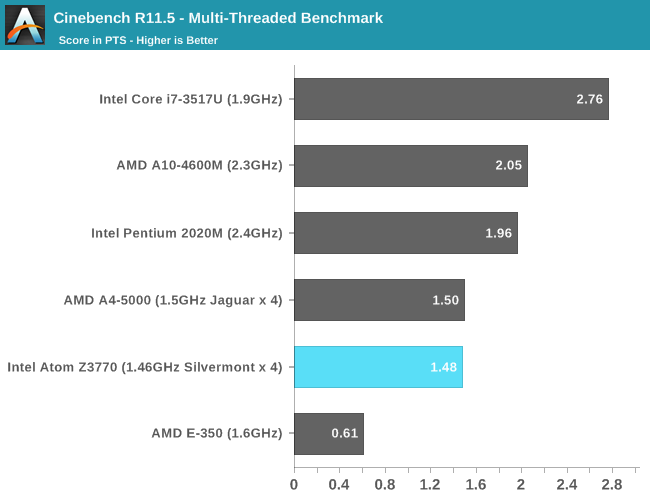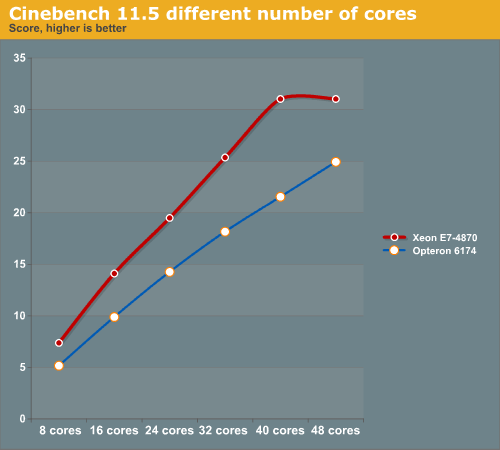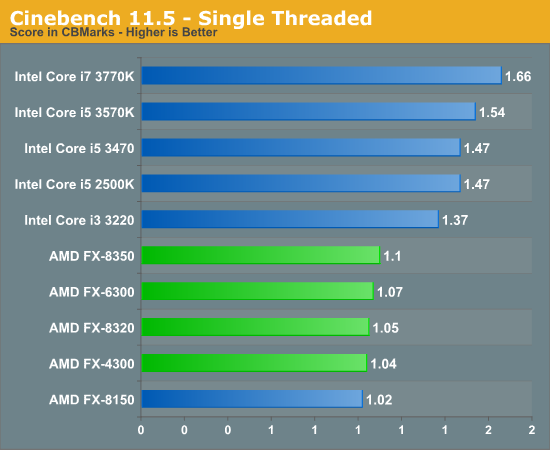My general suspicion was that AMD was quickly going no-where with their CPU tech and to maintain relevance cut really good deals for Sony and MS and that's why they have them. Intel left them in the dust long ago and nothing else will ever use Jaguar cores. Seems not too unlike where nVidia finds themselves in the mobile market.
-
Hey, guest user. Hope you're enjoying NeoGAF! Have you considered registering for an account? Come join us and add your take to the daily discourse.
You are using an out of date browser. It may not display this or other websites correctly.
You should upgrade or use an alternative browser.
You should upgrade or use an alternative browser.
Anandtech: Intel's new Atom CPU beats AMD's Jaguar in performance
- Thread starter Horse Armour
- Start date
My general suspicion was that AMD was quickly going no-where with their CPU tech and to maintain relevance cut really good deals for Sony and MS and that's why they have them. Intel left them in the dust long ago and nothing else will ever use Jaguar cores. Seems not too unlike where nVidia finds themselves in the mobile market.
They just have a different focus - price/performance/heat/power usage/combination CPU + GPU. No one else could compete with what AMD can bring to the table with a unified SoC. Intel has the CPU but their GPU tech is behind - so that would leave Sony/MS going to another party (i.e. NVIDIA) for the GPU. That's not where you want to be.
Dr. Kitty Muffins
Member
Yep, the 8 core ones in the consoles are just 2 4-core modules put together basically.
So we should probably just double the scores found here to get a rough estimate of the One/PS4 CPU performance, I guess.
So we should probably just double the scores found here to get a rough estimate of the One/PS4 CPU performance, I guess.
All the benchmarks displayed in the OP are single-threaded.
Lactose_Intolerant
Member
are there any multithreaded benchmarks for this comparison? That seems more relevant for gaming.
phosphor112
Banned
All the benchmarks displayed in the OP are single-threaded.
It's kind of disingenuous. As even in the link the there is a graph or two of the multi-threaded performance, with the Jaguar excelling or on par in places.
It also needs to be kept in mind that the PS4 and 360 have 8 Jaguar cores, not 4.
Arkam
Member
The way I read it, OP was noting how a new tablet/netbook cpu (NOT a 'desktop' cpu) is comparable to the cpus in the new consoles.
But honestly that should not be news to anyone. The CPUs in the X1/PS4 are incredibly weak compared to current desktop cpus.
Does that mean X1/PS4 are crap? Not even close!
BUT it does put current tech trends into perspective.
Much like how the iPhone is now as/more powerful than the once beastly Vita.
Its a crazy world we live in these days
But honestly that should not be news to anyone. The CPUs in the X1/PS4 are incredibly weak compared to current desktop cpus.
Does that mean X1/PS4 are crap? Not even close!
BUT it does put current tech trends into perspective.
Much like how the iPhone is now as/more powerful than the once beastly Vita.
Its a crazy world we live in these days
Only if those phones are able to push the same games out to my TV as my PS4 can.
Remote streaming is becoming more of a thing lately. Perhaps that is the "next gen" thing for phones/tablets to do in the (near?) future?
That will change with the debut of the new consoles. This will force the move to better multithreaded tasks on multiple cores in general and this should create a more interesting environment on both sides of the gaming (console to pc) fence.The thing is, we really have no idea how upcoming engines will run on these. As it is, 8 vs. 4 core makes no difference when you are talking about games. All about IPC and frequency right now.
If it's accurate with the actual CPUs in the PS4/Xbone thats pretty pathetic. Atom is bottom of the barrel and most atom pcs run like shit already.
That's due to the fact that they have only just updated the Atom microarchitecture now, for the first time in five years. Silvermont is a huge jump, and Airmont will only exacerbate that, Intel is probably going to lead the super low power tablet/phone processor market for perf/power consumption by next year.
JonathanPower
Member
are there any multithreaded benchmarks for this comparison? That seems more relevant for gaming.
Yes. In the multithreaded Cinebench test, which is more relevant for gaming, Jaguar performs marginally better than the new Atom.

dr. apocalipsis
Banned
That Atom CPU is most likely 22nm vs Jaguar 28nm so I would expect it to preform better at around the same clock rate on single threaded tasks
This.
You can also expect a 22nm AMD chip to run faster and more efficient than a 28nm one. Intel has a process node advantage and will keep leveraging that. It's too bad their current high-end GPUs top out at less than half of PS4's GPU ..
This actually make to Atom CPU look even worse in comparison because it barely edges the older Jaguar cores with the new 22nm process.
Nope, nope and nope.
Node integration affects power consumption and thermals, not efficiency or throughput. Intel is using the node advantage in the Atom series to compete against ARM in the watt/power race, not against AMD in the power race. Proof of that is that this new Atom is clocked lower than AMD offer.
Process node affects power and heat, it does not directly effect IPC.
These numbers also prove the whole "x86 is not competitive with ARM at the low end because x86 is inefficient" thing is just a load of bullshit by people that are stuck in the late 80's.
Pretty much.
dr. apocalipsis
Banned
An Atom, yes. A new Atom that is -- astonishingly -- more than twice as fast as any Atom you've ever seen, and is also technically not on sale anywere yet.
Just like next gen consoles.
Just in case you ever want to shut such people up hard (I know I had occasion to!):These numbers also prove the whole "x86 is not competitive with ARM at the low end because x86 is inefficient" thing is just a load of bullshit by people that are stuck in the late 80's.
http://research.cs.wisc.edu/vertical/papers/2013/hpca13-isa-power-struggles.pdf
rudieboy77
Member
Are these consoles going to be bottle necked by the cpu?
dr. apocalipsis
Banned
I helped make these, just saying!
Tell us more!
Are these consoles going to be bottle necked by the cpu?
You can't expect a GPU like the one present on PS4 to perform the same backed with a Core i5/Core i7 than with this crappy processor.
Yup, offload things to GPU means less resources for graphic rendering. And you can't run most CPU code on GPU anyway.
Gemüsepizza
Member
When looking at this graph:
It only shows the results for a 4-core Jaguar, which is 1.5. Wouldn't an 8-core Jaguar be able to achieve a result of 3.0 in this benchmark when it can use every core perfectly, which would be a better result than the Core-i7-3517U they used here? They also only used a 1.5GHz version of the Jaguar, which means a 1.6+GHz version would perform even better.
It only shows the results for a 4-core Jaguar, which is 1.5. Wouldn't an 8-core Jaguar be able to achieve a result of 3.0 in this benchmark when it can use every core perfectly, which would be a better result than the Core-i7-3517U they used here? They also only used a 1.5GHz version of the Jaguar, which means a 1.6+GHz version would perform even better.
Intel is scared senseless of the ARM steamroller and is putting major resources into power efficiency. This is not surprising at all, they have way more resources than AMD.
The question is can they find their way into phones and tablets in a big way.
They'll end up steam rolling the ARM market IMO. It's just a matter of time.
Yes, this is correct. Assuming ideal scaling the 8 core Jaguar it would be slightly better than the 1.9 GHz low power dual-core i7.Gemüsepizza;82372769 said:When looking at this graph:
It only shows the results for a 4-core Jaguar, which is 1.5. Wouldn't an 8-core Jaguar be able to achieve a result of 3.0 in this benchmark when it can use every core perfectly, which would be a better result then the Core-i7-3517U they used here? They also only used a 1.5GHz version of the Jaguar.
Gemüsepizza;82372769 said:When looking at this graph:
It only shows the results for a 4-core Jaguar, which is 1.5. Wouldn't an 8-core Jaguar be able to achieve a result of 3.0 in this benchmark when it can use every core perfectly, which would be a better result then the Core-i7-3517U they used here? They also only used a 1.5GHz version of the Jaguar.
Not even close to that. 100% improvement from double the cores isn't even a best case, perfect implementation scenario. More complicated chips mean more overhead to manage them. To make it as simple as possible, the more complicated it gets the more logic it must spend for it to work instead of computing. It's been 15 years since I studied these things though.
We can't say that for certain. Right now, it's not more relevant. There's very very few engines that use more than two cores. There's a ton that only use one.Yes. In the multithreaded Cinebench test, which is more relevant for gaming, Jaguar performs marginally better than the new Atom.

That's my hope.That will change with the debut of the new consoles. This will force the move to better multithreaded tasks on multiple cores in general and this should create a more interesting environment on both sides of the gaming (console to pc) fence.
Nah, it doesn't work like that.So we should probably just double the scores found here to get a rough estimate of the One/PS4 CPU performance, I guess.
Not even close to that. 100% improvement from double the cores isn't even a best case, perfect implementation scenario. More complicated chips mean more overhead to manage them. To make it as simple as possible, the more complicated it gets the more logic it must spend for it to work instead of computing. It's been 15 years since I studied these things though.
http://hpc.msu.ru/?q=node/59
From the link: 35,360 cores with 83% efficiency in linpack.
Try harder next time.
Just in case you ever want to shut such people up hard (I know I had occasion to!):
http://research.cs.wisc.edu/vertical/papers/2013/hpca13-isa-power-struggles.pdf
Thanks, I knew about that paper but forgot the link to it.
dr. apocalipsis
Banned
http://hpc.msu.ru/?q=node/59
From the link: 35,360 cores with 83% efficiency in linpack
Try harder next time
Linpack is just a measure of the FPU throughput based on loops of basic operations. So, it's easier for benchmarks like this one to scale with cores.
Try to inform yourself better next time.
In linpack.http://hpc.msu.ru/?q=node/59
From the link: 35,360 cores with 83% efficiency in linpack.
Try harder next time.
Edit: see above. Not that I expect the Cinebench workload to be particularly hard to scale, but making any conclusions about general parallel scaling from Linpack results is a bit rich.
There's a lot of ways you could phrase that without sounding like a snarky jerk.
Of course I could be nicer but I don't like people who spread nonsense.
Linpack is just a measure of the FPU throughput based on loops of basic operations. So, it's easier for benchmarks like this one to scale with cores.
Try to inform yourself better next time.
Cinebench scales very well when you increase core count.

source:http://www.tomshardware.com/reviews/core-i7-gulftown-scaling,2663-6.html

Anandtech: Cinebench scales very easily as can be noticed from looking at the 32 core and 40 core results of the Xeon E7-4870. Increase the core count by 25% and you get a 22.4% performance increase. The Opteron scales slightly worse. Compare the 48-core result with the 32 core one: a 50% increase in core counts gets you "only" a 37% increase in performance.
source: http://www.anandtech.com/show/4486/server-rendering-hpc-benchmark-session/3
dr. apocalipsis
Banned
And again, you use a synthetic benchmark that relies heavily on FP to prove your point. And, at the same time, you decide to ignore real world workloads from your own link. Results change when you have to do things other than crunch numbers inside your own cache:


We can also have a look at gaming benchmarks:

But we can go as far as this:

Just as xenist said, Not even close to 100%.


We can also have a look at gaming benchmarks:

But we can go as far as this:

Just as xenist said, Not even close to 100%.
And again, you use a synthetic benchmark that relies heavily on FP to prove your point. And, at the same time, you decide to ignore real world workloads from your own link.
I responded to someone who doubted cinebench scaling, I never said this results will translate to a similar performance increase in real life .
But we can go as far as this:

Just as xenist said, Not even close to 100%.
Maybe I misunderstand this graph but if it tries to prove that going from 4cores to 8 cores hardly matters it must be doing something wrong.
Anandtech shows much better scaling going from single to multithreaded. (6,89/1,1=6,26) You also have to take into account that Turbo Boost increase the single core performance.


dr. apocalipsis
Banned
Maybe I misunderstand this graph but if it tries to prove that going from 4cores to 8 cores hardly matters it must be doing something wrong.
Nope. It just proves how Cinebench relies on FPU (SSE). Bulldozer architecture have 1 FPU for every 2 integer cores. So moving from 4 integer + 4 fpu to 8 integer + 4 fpu (4 modules) doesn't increase performance at all.
Synthetic benchmarks =/= real world workloads.
These benchmarks are misleading as fuck. Intel's new Atom CPU beats AMD's months (nearly a year) old Jaguar... lol
This actually make to Atom CPU look even worse in comparison because it barely edges the older Jaguar cores with the new 22nm process.
And this is why I don't read Anandtech or most mainstream tech sites. Zero perspective and context.
Edit: also, what's the price of this Atom chip? Price/performance ratios matter a lot in this market segment.
No, this is a BGA solution, soldered to the motherboard.Will this new intel chip be compatible with Haswell mobos?
The Abominable Snowman
Member
Will this new intel chip be compatible with Haswell mobos?
Why would you want to replace Haswell with an Atom?
DirgeExtinction
Member
Huh. For some reason, I was under the impression the new consoles included AMD's A10 APU. Guess I was wrong.
Pretty interesting numbers, though.
Pretty interesting numbers, though.
-COOLIO-
The Everyman
funny story, the new iphone a7 chip is about on par with the high end atom:
http://anandtech.com/show/7335/the-iphone-5s-review
http://anandtech.com/show/7335/the-iphone-5s-review
And this is why I don't read Anandtech or most mainstream tech sites. Zero perspective and context.
Edit: also, what's the price of this Atom chip? Price/performance ratios matter a lot in this market segment.
So you don't read Anandtech because you believe a poster talking out his arse.
funny story, the new iphone a7 chip is about on par with the high end atom:
http://anandtech.com/show/7335/the-iphone-5s-review
Those benchmarks are single threaded (the Atom has 4 cores vs 2 in the new iPhone) and are web based and thus depend on how fast the browser is also.
So you don't read Anandtech because you believe a poster talking out his arse.
No, his reasons are perfectly valid; we'll get a more accurate comparison once AMD's new chips come out later this year (or early next).
I'd also like to address the "faster chips due to smaller process" points too: smaller processes don't magically make a chip faster, but rather allow for faster clocks/processes due to completely indirect effects. I like to make the analogy of "headroom" (for threshold voltages, frequencies, tracing/race conditions, etc) such that the designer can tweak various parts of the chip for more performance. I actually teach a course related to process tech and manufacturing too...
Speaking of processes, the more exciting news of today is Intel's new Quark chip -- that's the new ARM competitor if the price is right.
http://hpc.msu.ru/?q=node/59
From the link: 35,360 cores with 83% efficiency in linpack.
Try harder next time.
You have no idea what you're talking about.
One of his points was that Jaguar is much older, ignoring that it is not that much older and that CPUs don't advance super fast anymore.
A year is an eternity in this business though. Even six months is eternity.
ThoseDeafMutes
Member
Yes, this is correct. Assuming ideal scaling the 8 core Jaguar it would be slightly better than the 1.9 GHz low power dual-core i7.
But you see Durante, uh, the Jaguars would uh, be coded to the metal, and uh, therefore are twice as powerful, uh.
Power consumption and heat?
My asus windows 8 tablet has 10 hours of battery life.
